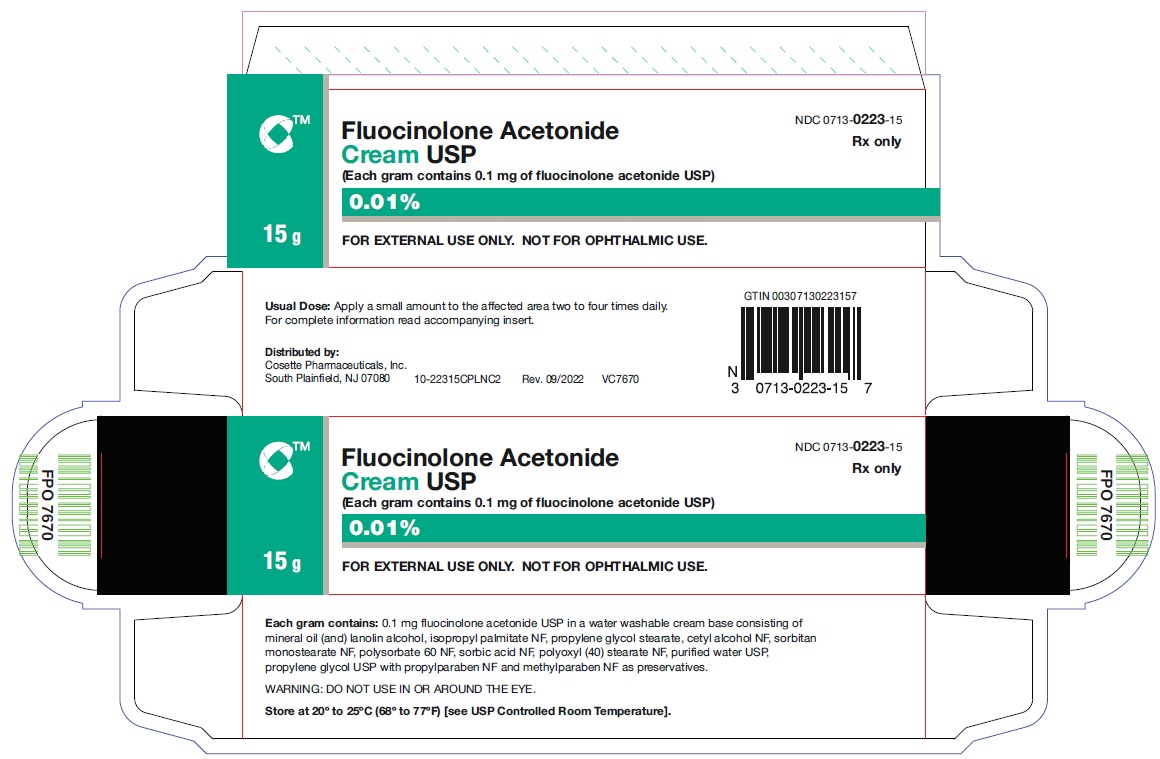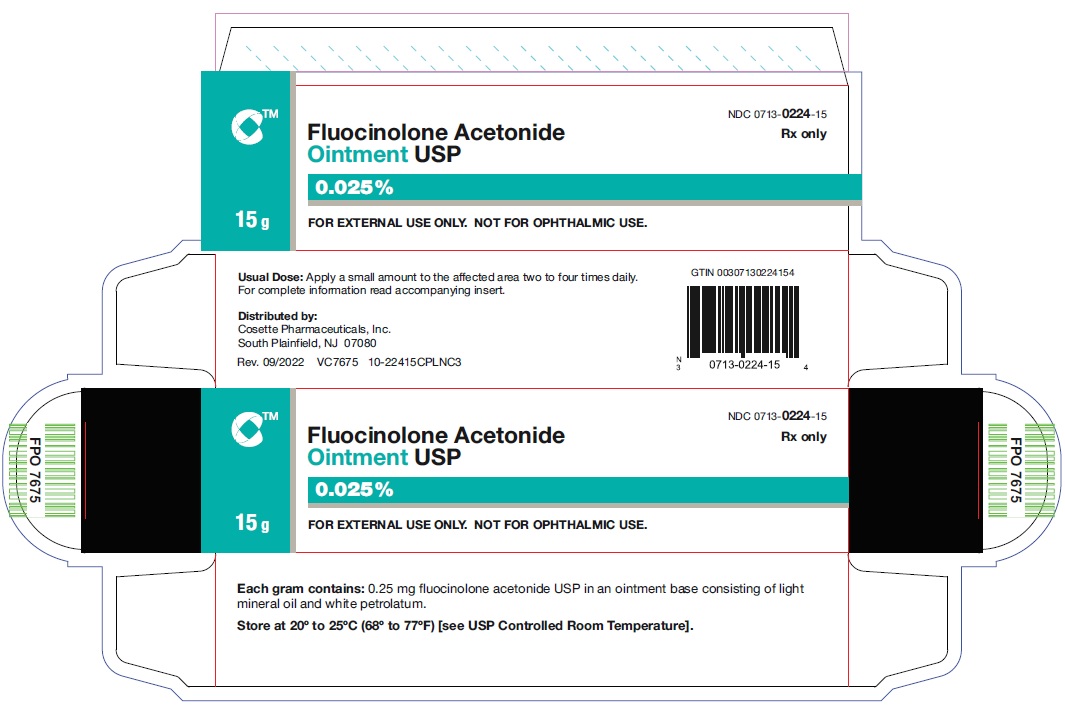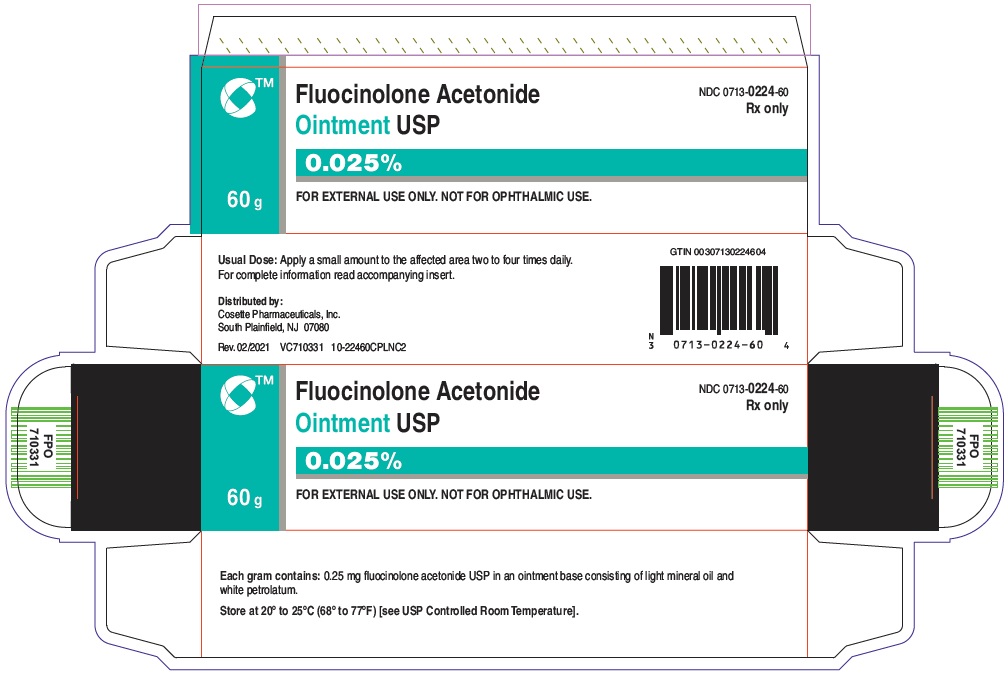Label: FLUOCINOLONE ACETONIDE cream
FLUOCINOLONE ACETONIDE ointment
-
NDC Code(s):
0713-0222-15,
0713-0222-60,
0713-0223-15,
0713-0223-60, view more0713-0224-15, 0713-0224-60
- Packager: Cosette Pharmaceuticals, Inc.
- Category: HUMAN PRESCRIPTION DRUG LABEL
Drug Label Information
Updated November 22, 2023
If you are a healthcare professional or from the pharmaceutical industry please visit this version.
- Download DRUG LABEL INFO: PDF XML
- Official Label (Printer Friendly)
-
DESCRIPTION
The topical corticosteroids constitute a class of primarily synthetic steroids used as anti-inflammatory and anti-pruritic agents. Fluocinolone Acetonide is included in this class of synthetic corticosteroids.
Chemically Fluocinolone Acetonide is Pregna-1,4-diene-3,20-dione, 6,9-difluoro-11,21-dihydroxy-16,17-[(1-methylethylidene)bis(oxy)]-, (6α, 11β, 6α)-), with the molecular formula C 24H 30F 20 6, a molecular weight of 452.49 and the following structural formula:

Each gram of Fluocinolone Acetonide Cream, USP 0.01% contains 0.1 mg fluocinolone acetonide USP in a water washable cream base consisting of mineral oil (and) lanolin alcohols, isopropyl palmitate NF, propylene glycol stearate, cetyl alcohol NF, sorbitan monostearate NF, polysorbate 60 NF, sorbic acid NF, polyoxyl (40) stearate NF, purified water USP, propylene glycol USP with propylparaben NF and methylparaben NF as preservatives.
Each gram of Fluocinolone Acetonide Ointment, USP 0.025% contains 0.25 mg of fluocinolone acetonide USP in an ointment base consisting of light mineral oil NF and white petrolatum USP.
-
CLINICAL PHARMACOLOGY
Topical corticosteroids share anti-inflammatory, anti-pruritic and vasoconstrictive actions.
The mechanism of anti-inflammatory activity of the topical corticosteroids is unclear. Various laboratory methods, including vasoconstrictor assays, are used to compare and predict potencies and/or clinical efficacies of the topical corticosteroids. There is some evidence to suggest that a recognizable correlation exists between vasoconstrictor potency and therapeutic efficacy in man.
Pharmacokinetics: The extent of percutaneous absorption of topical corticosteroids is determined by many factors including the vehicle, the integrity of the epidermal barrier, and the use of occlusive dressings.
Topical corticosteroids can be absorbed from normal intact skin. Inflammation and/or other disease processes in the skin increase percutaneous absorption. Occlusive dressings substantially increase the percutaneous absorption of topical corticosteroids. Thus, occlusive dressings may be a valuable therapeutic adjunct for treatment of resistant dermatoses, (See DOSAGE AND ADMINISTRATION).
Once absorbed through the skin, topical corticosteroids are handled through pharmacokinetic pathways similar to systemically administered corticosteroids. Corticosteroids are bound to plasma proteins in varying degrees. Corticosteroids are metabolized primarily in the liver and are then excreted by the kidneys. Some of the topical corticosteroids and their metabolites are also excreted in the bile.
- INDICATIONS AND USAGE
- CONTRAINDICATIONS
-
PRECAUTIONS
General: Systemic absorption of topical corticosteroids has produced reversible hypothalamic-pituitary-adrenal (HPA) axis suppression, manifestations of Cushing's syndrome, hyperglycemia, and glucosuria in some patients.
Conditions which augment systemic absorption include the application of the more potent steroids, use over large surface areas, prolonged use, and the addition of occlusive dressings.
Therefore, patients receiving a large dose of a potent topical steroid applied to a large surface area or under an occlusive dressing should be evaluated periodically for evidence of HPA axis suppression by using the urinary free cortisol and ACTH stimulation tests. If HPA axis suppression is noted, an attempt should be made to withdraw the drug, to reduce the frequency of application, or to substitute a less potent steroid.
Recovery of HPA axis function is generally prompt and complete upon discontinuation of the drug. Infrequently, signs and symptoms of steroid withdrawal may occur, requiring supplemental systemic corticosteroids.
Children may absorb proportionally larger amounts of topical corticosteroids and thus be more susceptible to systemic toxicity (See PRECAUTIONS- Pediatric Use).
If irritation develops, topical corticosteroids should be discontinued and appropriate therapy instituted.
As with any topical corticosteroid product, prolonged use may produce atrophy of the skin and subcutaneous tissues. When used on intertriginous or flexor areas, or on the face, this may occur even with short-term use.
In the presence of dermatological infections, the use of an appropriate antifungal or antibacterial agent should be instituted. If a favorable response does not occur promptly, the corticosteroid should be discontinued until the infection has been adequately controlled.
Information for the Patient:Patients using topical corticosteroids should receive the following information and instructions:
- This medication is to be used as directed by the physician. It is for external use only. Avoid contact with the eyes.
- Patients should be advised not to use this medication for any disorder other than for which it was prescribed.
- The treated skin area should not be bandaged or otherwise covered or wrapped as to be occlusive unless directed by the physician.
- Patients should report any signs of local adverse reactions, especially under occlusive dressing.
- Parents of pediatric patients should be advised not to use tight-fitting diapers or plastic pants on a child being treated in the diaper area, as these garments may constitute occlusive dressings.
Laboratory Tests: The following tests may be helpful in evaluating the HPA axis suppression:
Urinary free cortisol test
ACTH stimulation testCarcinogenesis, Mutagenesis, and Impairment of Fertility:Long-term animal studies have not been performed to evaluate the carcinogenic potential or the effect on fertility of topical corticosteroids.
Studies to determine mutagenicity with prednisolone and hydrocortisone have revealed negative results.
Pregnancy Category C:Corticosteroids are generally teratogenic in laboratory animals when administered systemically at relatively low dosage levels. The more potent corticosteroids have been shown to be teratogenic after dermal application in laboratory animals. There are no adequate and well-controlled studies in pregnant women on teratogenic effects from topically applied corticosteroids. Therefore, topical corticosteroids should be used during pregnancy only if the potential benefit justifies the potential risk to the fetus. Drugs of this class should not be used extensively on pregnant patients, in large amounts, or for prolonged periods of time.
Nursing Mothers:It is not known whether topical administration of corticosteroids could result in sufficient systemic absorption to produce detectable quantities in breast milk. Systemically administered corticosteroids are secreted into breast milk in quantities not likely to have a deleterious effect on the infant. Nevertheless, caution should be exercised when topical corticosteroids are administered to a nursing woman.
Pediatric Use:Pediatric patients may demonstrate greater susceptibility to topical corticosteroid-induced hypothalamic-pituitary-adrenal (HPA) axis suppression and Cushing's syndrome than mature patients because of a larger skin surface area to body weight ratio.
HPA axis suppression, Cushing's syndrome, and intracranial hypertension have been reported in children receiving topical corticosteroids. Manifestations of adrenal suppression in children include linear growth retardation, delayed weight gain, low plasma cortisol levels, and absence of response to ACTH stimulation. Manifestations of intracranial hypertension include bulging fontanelles, headaches, and bilateral papilledema.
Administration of topical corticosteroids to children should be limited to the least amount compatible with an effective therapeutic regimen. Chronic corticosteroid therapy may interfere with the growth and development of children.
-
ADVERSE REACTIONS
The following local adverse reactions are reported infrequently with topical corticosteroids, but may occur more frequently with the use of occlusive dressings. These reactions are listed in an approximate decreasing order of occurrence: Burning, Itching, Irritation, Dryness, Folliculitis, Hypertrichosis, Acneiform eruptions, Hypopigmentation, Perioral dermatitis, Allergic contact dermatitis, Maceration of the skin, Secondary infection, Skin atrophy, Striae and Miliaria.
To report SUSPECTED ADVERSE REACTIONS, contact Cosette Pharmaceuticals, Inc. at 1-800-922-1038 or FDA at 1-800-FDA-1088 or www.fda.gov/medwatch.
-
OVERDOSAGE
Topically applied corticosteroids can be absorbed in sufficient amounts to produce systemic effects (See PRECAUTIONS).
-
DOSAGE AND ADMINISTRATION
Topical corticosteroids are generally applied to the affected area as a thin film from two to four times daily depending on the severity of the condition. In hairy sites, the hair should be parted to allow direct contact with the lesion.
Occlusive dressings may be used for the management of psoriasis or recalcitrant conditions. Some plastic films may be flammable and due care should be exercised in their use. Similarly, caution should be employed when such films are used on children or left in their proximity, to avoid the possibility of accidental suffocation.
If an infection develops, the use of occlusive dressings should be discontinued and appropriate antimicrobial therapy instituted.
-
HOW SUPPLIED
Fluocinolone Acetonide Cream, USP 0.01% is supplied in: 15 g tubes NDC 0713-0223-15, and 60 g tubes NDC 0713-0223-60
Fluocinolone Acetonide Ointment, USP 0.025% USP is supplied in: 15 g tubes NDC 0713-0224-15, and 60 g tubes NDC 0713-0224-60
Store at 20° to 25°C (68° to 77°F) [see USP Controlled Room Temperature].
Distributed by:
Cosette Pharmaceuticals, Inc.
South Plainfield, NJ 07080VC7669
Rev. 09/2022 8-FLUOCPLNC3
- Principal Display Panel
-
Principal Display Panel
NDC 0713-0224-15
Fluocinolone Acetonide Ointment, USP 0.025%
15 g
FOR EXTERNAL USE ONLY. NOT FOR OPHTHALMIC USE.
Rx only
Cosette Pharmaceuticals, Inc.

NDC 0713-0224-60
Fluocinolone Acetonide Ointment, USP 0.025%
60 g
FOR EXTERNAL USE ONLY. NOT FOR OPHTHALMIC USE.
Rx only
Cosette Pharmaceuticals, Inc.

-
INGREDIENTS AND APPEARANCE
FLUOCINOLONE ACETONIDE
fluocinolone acetonide creamProduct Information Product Type HUMAN PRESCRIPTION DRUG Item Code (Source) NDC:0713-0222 Route of Administration TOPICAL Active Ingredient/Active Moiety Ingredient Name Basis of Strength Strength FLUOCINOLONE ACETONIDE (UNII: 0CD5FD6S2M) (FLUOCINOLONE ACETONIDE - UNII:0CD5FD6S2M) FLUOCINOLONE ACETONIDE 0.25 mg in 1 g Inactive Ingredients Ingredient Name Strength MINERAL OIL (UNII: T5L8T28FGP) LANOLIN ALCOHOLS (UNII: 884C3FA9HE) ISOPROPYL PALMITATE (UNII: 8CRQ2TH63M) PROPYLENE GLYCOL STEARATE (UNII: MZM1I680W0) CETYL ALCOHOL (UNII: 936JST6JCN) SORBITAN MONOSTEARATE (UNII: NVZ4I0H58X) POLYSORBATE 60 (UNII: CAL22UVI4M) SORBIC ACID (UNII: X045WJ989B) POLYOXYL 40 STEARATE (UNII: 13A4J4NH9I) WATER (UNII: 059QF0KO0R) PROPYLENE GLYCOL (UNII: 6DC9Q167V3) PROPYLPARABEN (UNII: Z8IX2SC1OH) METHYLPARABEN (UNII: A2I8C7HI9T) Packaging # Item Code Package Description Marketing Start Date Marketing End Date 1 NDC:0713-0222-15 1 in 1 CARTON 07/26/1988 02/28/2015 1 15 g in 1 TUBE; Type 0: Not a Combination Product 2 NDC:0713-0222-60 1 in 1 CARTON 07/26/1988 02/28/2015 2 60 g in 1 TUBE; Type 0: Not a Combination Product Marketing Information Marketing Category Application Number or Monograph Citation Marketing Start Date Marketing End Date ANDA ANDA089525 07/26/1988 02/28/2015 FLUOCINOLONE ACETONIDE
fluocinolone acetonide creamProduct Information Product Type HUMAN PRESCRIPTION DRUG Item Code (Source) NDC:0713-0223 Route of Administration TOPICAL Active Ingredient/Active Moiety Ingredient Name Basis of Strength Strength FLUOCINOLONE ACETONIDE (UNII: 0CD5FD6S2M) (FLUOCINOLONE ACETONIDE - UNII:0CD5FD6S2M) FLUOCINOLONE ACETONIDE 0.1 mg in 1 g Inactive Ingredients Ingredient Name Strength MINERAL OIL (UNII: T5L8T28FGP) LANOLIN ALCOHOLS (UNII: 884C3FA9HE) ISOPROPYL PALMITATE (UNII: 8CRQ2TH63M) PROPYLENE GLYCOL STEARATE (UNII: MZM1I680W0) CETYL ALCOHOL (UNII: 936JST6JCN) SORBITAN MONOSTEARATE (UNII: NVZ4I0H58X) POLYSORBATE 60 (UNII: CAL22UVI4M) SORBIC ACID (UNII: X045WJ989B) POLYOXYL 40 STEARATE (UNII: 13A4J4NH9I) WATER (UNII: 059QF0KO0R) PROPYLENE GLYCOL (UNII: 6DC9Q167V3) PROPYLPARABEN (UNII: Z8IX2SC1OH) METHYLPARABEN (UNII: A2I8C7HI9T) Packaging # Item Code Package Description Marketing Start Date Marketing End Date 1 NDC:0713-0223-15 1 in 1 CARTON 07/26/1988 1 15 g in 1 TUBE; Type 0: Not a Combination Product 2 NDC:0713-0223-60 1 in 1 CARTON 07/26/1988 2 60 g in 1 TUBE; Type 0: Not a Combination Product Marketing Information Marketing Category Application Number or Monograph Citation Marketing Start Date Marketing End Date ANDA ANDA089526 07/26/1988 FLUOCINOLONE ACETONIDE
fluocinolone acetonide ointmentProduct Information Product Type HUMAN PRESCRIPTION DRUG Item Code (Source) NDC:0713-0224 Route of Administration TOPICAL Active Ingredient/Active Moiety Ingredient Name Basis of Strength Strength FLUOCINOLONE ACETONIDE (UNII: 0CD5FD6S2M) (FLUOCINOLONE ACETONIDE - UNII:0CD5FD6S2M) FLUOCINOLONE ACETONIDE 0.25 mg in 1 g Inactive Ingredients Ingredient Name Strength LIGHT MINERAL OIL (UNII: N6K5787QVP) PETROLATUM (UNII: 4T6H12BN9U) Packaging # Item Code Package Description Marketing Start Date Marketing End Date 1 NDC:0713-0224-15 1 in 1 CARTON 07/26/1988 1 15 g in 1 TUBE; Type 0: Not a Combination Product 2 NDC:0713-0224-60 1 in 1 CARTON 07/26/1988 2 60 g in 1 TUBE; Type 0: Not a Combination Product Marketing Information Marketing Category Application Number or Monograph Citation Marketing Start Date Marketing End Date ANDA ANDA089524 07/26/1988 Labeler - Cosette Pharmaceuticals, Inc. (116918230) Establishment Name Address ID/FEI Business Operations Cosette Pharmaceuticals NC Laboratories, LLC 079419931 manufacture(0713-0224, 0713-0223)






